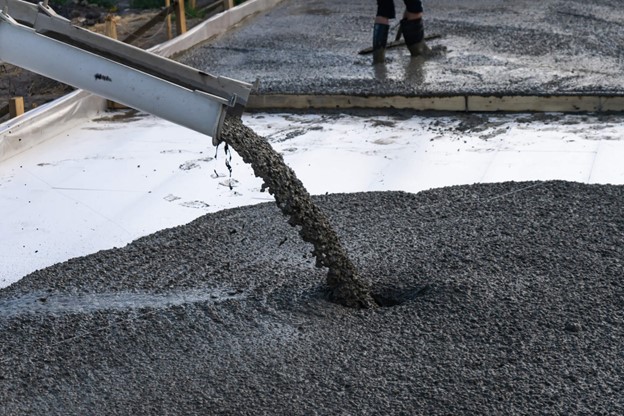How Long Does Concrete Take to Dry?
How Long Does Concrete Take to Dry in Texas and Louisiana?
Concrete is a workhorse material in construction, but when it comes to timing your project, understanding how long it takes to dry is key. Knowing how long it takes for concrete to dry becomes even more important if you’re in Texas or Louisiana, where the temperatures and humidity fluctuate significantly. At Ashton Sawing and Drilling LLC, where we pour foundation, pave parking lots, and build outdoor features, environmental factors and the curing process can heavily influence drying times. Below, we’ll provide insights on the concrete drying process, factors that affect curing, and tips to ensure your project achieves optimal results.
Understanding the Curing Process
Before digging into specifics, it’s essential to clarify a common misconception. Concrete doesn’t technically “dry” like paint. Instead, it cures. Curing is the chemical process where water, cement, and aggregate interact to form a hard and durable material. This process, known as hydration, can take up to 28 days to complete, but that doesn’t mean the concrete isn’t usable before the drying process is finished. Here’s a breakdown of curing milestones:
- Initial Set (24-48 hours) – The concrete hardens enough to walk on and forms its basic shape.
- Partial Strength (7 days) – Around 70% of the concrete’s strength develops within the first week.
- Full Cure (28 days) – The curing process is complete, and the concrete reaches maximum strength.
What Makes Concrete Harden?
The hardening process of concrete, known as curing, results from the hydration reaction between water and cement. During this chemical reaction, calcium silicate hydrate is formed, which acts as the glue that binds aggregates, sand, and other materials in the mixture to create a solid and durable structure. However, the hydration process relies heavily on moisture retention to proceed effectively. If the water in the concrete evaporates too quickly due to factors such as high temperatures, low humidity, or strong winds, the curing process is disrupted. This can lead to insufficient hydration, resulting in weaker, brittle, or cracked concrete, compromising its strength and longevity.
Factors That Affect Drying Times
Several external and internal factors impact how long it takes for cement to dry, particularly in Texas and Louisiana, where unique climate conditions come into play. These factors include:
Weather Conditions
- High Temperatures – Texas and Louisiana often experience extreme heat. High temperatures can accelerate water evaporation, leading to quicker drying but risking cracks.
- Humidity Levels – Louisiana’s humid climate can slow down concrete curing times. More humidity means less rapid evaporation, which often helps achieve stronger concrete.
- Rain and Storms – Sudden rain, common in Louisiana’s Gulf regions, can delay curing and disrupt freshly poured concrete. Proper covers or tarps can protect against this.
- Cold Weather – Though rare, freezing conditions in Texas winters can halt curing. Concrete requires a minimum temperature of about 40°F to cure effectively.
Types of Concrete Mix
- Fast-Setting Mixes – Common for quick repairs, these dry within hours, but may not achieve the same strength.
- Heavy Duty Mixes – Used for industrial or structural projects, these often take longer to cure but provide superior strength and durability.
Project Requirements
- Structural Foundations – These require more precise curing and extended periods since they bear significant loads. Full strength can take up to 28 days.
- Industrial Floors – An industrial floor project could require a longer curing period of up to 60 days or more for optimal performance.
Tips for Ensuring Proper Curing
Proper curing ensures strong, durable concrete, and while some factors like weather are out of your control, these strategies can help you achieve ideal results. Here are some tips for ensuring proper curing:
- Control Water Retention – Since hydration relies on retaining moisture, use curing blankets or plastic sheeting to keep the moisture locked in the concrete. You can also mist the surface regularly to prevent it from drying out too quickly.
- Use Curing Compounds – Curing compounds act as sealants, slowing water evaporation. This is especially helpful in the hot climates of Texas or during summer construction projects in Louisiana.
- Protect From Temperature Extremes – During hot weather, use shade or covers to shield the concrete from direct sunlight. For colder weather, consider warming blankets to maintain the concrete’s temperature.
- Test Before Use – If you’re unsure about the curing progress, perform a concrete strength test using tools like a Schmidt rebound hammer. This will help gauge whether the concrete is ready to bear loads.
Ensure Your Concrete Project Stands the Test of Time
Understanding the concrete drying process in Texas and Louisiana is critical for achieving a durable and long-lasting outcome. From managing weather factors to using the proper curing techniques, the steps you take during this process will determine the strength and functionality of your project. Now that you know how long it takes for concrete to dry and the factors that affect it, you’re one step closer to ensuring success. Still have questions or need professional guidance? Contact us today for expert tips and quality service.

